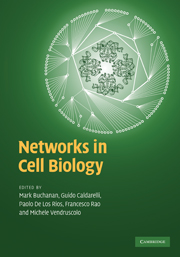Book contents
- Frontmatter
- Contents
- List of contributors
- Introduction
- 1 Network views of the cell
- 2 Transcriptional regulatory networks
- 3 Transcription factors and gene regulatory networks
- 4 Experimental methods for protein interaction identification
- 5 Modeling protein interaction networks
- 6 Dynamics and evolution of metabolic networks
- 7 Hierarchical modularity in biological networks: the case of metabolic networks
- 8 Signalling networks
- Appendix A Complex networks: from local to global properties
- Appendix B Modelling the local structure of networks
- Appendix C Higher-order topological properties
- Appendix D Elementary mathematical concepts
- References
- Index
5 - Modeling protein interaction networks
Published online by Cambridge University Press: 05 June 2012
- Frontmatter
- Contents
- List of contributors
- Introduction
- 1 Network views of the cell
- 2 Transcriptional regulatory networks
- 3 Transcription factors and gene regulatory networks
- 4 Experimental methods for protein interaction identification
- 5 Modeling protein interaction networks
- 6 Dynamics and evolution of metabolic networks
- 7 Hierarchical modularity in biological networks: the case of metabolic networks
- 8 Signalling networks
- Appendix A Complex networks: from local to global properties
- Appendix B Modelling the local structure of networks
- Appendix C Higher-order topological properties
- Appendix D Elementary mathematical concepts
- References
- Index
Summary
Introduction
Most of biology is interpreted via macromolecular interactions. Protein interaction networks represent the first genome-wide drafts of those interactions and have been explored as models for understanding cellular processes. Given the constant flow of new experimental data on the correlation of genes and proteins within an organism or even between different species, there is the need to rationalize in a solid framework the thousands of possible protein interactions inferred by experiments. Computational models can help in this task investigating the microscopic mechanisms responsible for the behaviors observed in experiments as different as yeast two-hybrid, mass spectroscopy, gene co-expression, synthetic lethality, just to mention the most popular.
In protein interaction networks, nodes and links represent the proteins and the interactions between them, respectively (Fig. 5.1). However, depending on the approach that has been used to generate the map, a link does not always indicate a direct physical interaction. It can also represent correlated expression in the cell, performance of successive steps in a metabolic pathway, similar genomic context and so on. Observation of direct binding is a good indication that two interacting proteins cooperate in the same biological pathway and whenever possible this chapter will restrict to this type of interactions.
Modeling can focus on different network properties. Some approaches use evolutionary arguments. Others take into account genomic information as well as the physico-chemical properties of proteins in a statistical way.
- Type
- Chapter
- Information
- Networks in Cell Biology , pp. 83 - 92Publisher: Cambridge University PressPrint publication year: 2010



